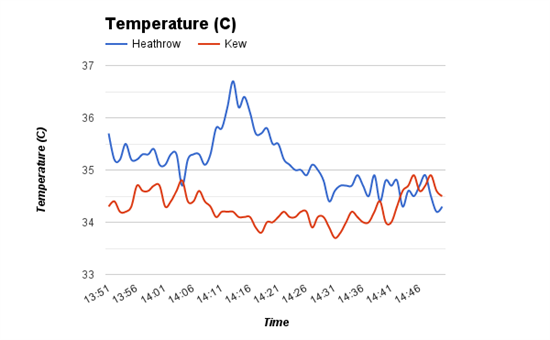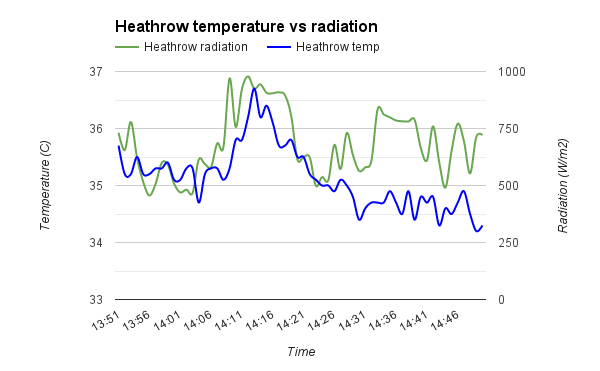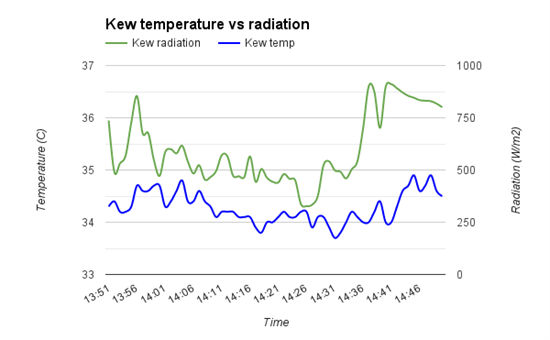
Met Office: Wind data dispels doubt about cause of Heathrow high temperatures
Roz Pidcock
07.16.15Roz Pidcock
16.07.2015 | 1:10pmEarlier this week, The Telegraph claimed the Met Office was “forced to defend” the credibility of the record high July temperatures recorded at Heathrow airport during the recent UK heatwave.
But a quick look at the temperature and wind data and a chat with Dr Mark McCarthy, head of the Met Office’s National Climate Information Centre, shows why claims that we shouldn’t trust the data don’t stand up to scrutiny.
McCarthy tells Carbon Brief:
“It would be wrong to reject observations on the basis of a hunch…In this instance there is no compelling evidence to suggest the measurement is incorrect.”
Record high
On Wednesday 1 July, a thermometer at Heathrow recorded 36.7C, the highest temperature anywhere in the UK that day.
The blue line below shows the air temperature recorded 1.5 metres off the ground at the Heathrow weather station for an hour-long period from 13:51pm-14:50pm on 1 July.
You can see a spike at 14:13pm when temperatures rose above 36C, leading the Met Office to declare 1 July as the “hottest July day since records began and the hottest day since 2003”.
Air temperature (C) at Heathrow (blue) and Kew (red) on 1 July. For a longer time period, see the Met Office News Blog from 7 July. Source: Met Office data, plotted by Carbon Brief.
But others were “not so sure”, said The Telegraph. The article centred on climate skeptic blogger Paul Homewood’s claim that the Heathrow data had likely been skewed by passing aircraft or a change in wind. This came from his observation that the nearby Kew weather station (shown in red in the graph above) did not show a similar spike in temperature.
The Telegraph says:
“Mr Homewood said…that extra heat could have been generated by the heat from a nearby runway which would have been experiencing a busy Wednesday afternoon. Thermometers surrounded by tarmac have been known to exaggerate heat conditions if the wind suddenly changes direction.”
Homewood is quoted in The Telegraph as saying:
“No engineer would trust such a spike in any other field and would throw it out unless he had firm evidence that it was correctâ?¦It is hard to avoid the conclusion that the reading at the Met Office station at Heathrow is either incorrect, or has been artificially inflated by local, non-climatic factors.”
Homewood’s argument was also picked up by Sunday Telegraph skeptic columnist Christopher Booker two weeks in a row, whose article this week carried the headline:
“Met Office caught out over its ‘hottest July day ever’ claim”
But Homewood’s suggestion that the high temperature is down to little more than a change in wind on the hot tarmac is easily checkable. The Met Office will release an hour or so of weather station data for free, since it’s unlikely to serve any commercial purpose.
So, Carbon Brief asked for it.
Winds of change
The plot below from the Met Office shows wind data for the same period as shown above for temperature. Arrows show the direction from which the wind was blowing. The data is plotted in five-minute intervals over an hour-long period, centred on 14:13pm when the temperature record was reached.
You can see the wind direction remains fairly stable from a southeasterly direction, McCarthy tells Carbon Brief:
“We’ve looked at wind data and there is no sudden change in wind direction at Heathrow around the time of the record.”
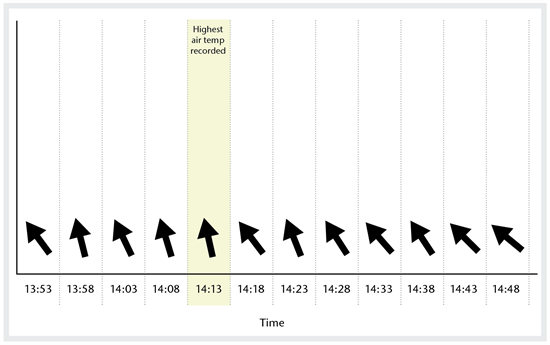
Wind direction at Heathrow on 1 July from 13:51-14:50pm at five-minute intervals, centred on 14:13pm when the highest temperature was recorded. Source: Met Office graph
Here’s a zoomed-in plot of minute-by-minute wind direction data for the five minutes either side of the 14:13pm temperature record.
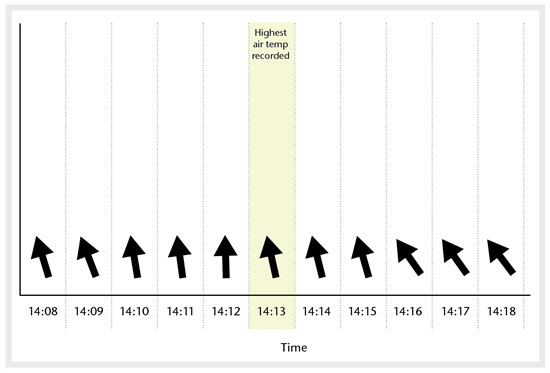
Wind direction at Heathrow on 1 July from 14:08-14:18pm at one-minute intervals, centred on 14:13pm when the highest temperature was recorded. Source: Met Office graph
Again, there is no sudden shift. You can see only a tiny difference at 14:13pm compared to 14:12pm, says McCarthy, but this is not enough to cause a strong temperature change.
Nor does it make sense to think that a passing breeze could have carried a waft of heat from a nearby aircraft, as Homewood suggests. McCarthy tells Carbon Brief:
“We have checked with [air traffic control] and confirmed that the north runway, which is closest in proximity to our observing station, was being used for landing aircraft. Therefore, landing aircraft would most likely have had idle engines by the time they reached the eastern half of the runway, where our observation station is sited.”
Had passing aircraft generated turbulence, that would help mix the air close to the ground. This would be more likely to lower the air temperature than raise it, McCarthy says.
Cloud cover
So, what did cause the sharp peak in temperature at Heathrow? Any why not at Kew?
Many factors can contribute to temperature differences between the two sites, McCarthy tells Carbon Brief. As the Telegraph noted, a Met Office news blog on 7 July explained that a break in the clouds can raise temperatures by allowing more solar radiation to reach the ground.
Here’s the air temperature at Heathrow again for 1 July (blue line), but this time with solar radiation data for the same period (green line). You can see a high in solar radiation at around 2:15pm, the same time as the peak in temperature.
Ground temperature (C) (blue) and solar radiation (green) on 1 July at Heathrow. Source: Met Office data, plotted by Carbon Brief.
In McCarthy’s opinion, the significant increase in solar radiation is “the most plausible and sufficient explanation” for the peak in temperatures. He tells Carbon Brief:
“Solar radiation readings at both sites show that at the time the record temperature was recorded there was a break in the clouds at Heathrow, with sunshine adding extra warmth, while it remained cloudy over our station at Kew – which explains the slight difference between the two.”
For comparison, here’s the same plot of temperature and radiation but for Kew. You can see there is no peak in solar radiation or temperature.
Ground temperature (C) (blue) and solar radiation (green) on 1 July at Kew. Source: Met Office data, plotted by Carbon Brief.
You can see our summary spreadsheet for the full temperature, wind direction and solar radiation data we obtained from the Met Office.
A reliable station
From the Met Office’s point of view, it would indeed be concerning if Heathrow temperatures were unduly biased by aircraft exhaust, McCarthy tells Carbon Brief. But, he adds:
“Because it is a very busy airport, such effects would not be confined to one day. So we should look at the longer data records, rather than one specific time on one specific day.”
Those longer records show that Heathrow and Kew typically see similar maximum temperatures, though not always at exactly the same time. He tells Carbon Brief:
“On any one day they can differ from each other by wider margin than recorded on 1 July, with Kew being warmer than Heathrow nearly as much as the other way around.”
In other words, there is no evidence of a temperature bias at Heathrow, McCarthy says.
Heatwave
McCarthy also points out that many other temperature stations across the UK saw record temperatures on 1 July besides Heathrow. So the record for hottest July day was based on much more than just the Heathrow high temperature, he tells Carbon Brief:
“The breaking of records at other stations (including Kew) on 1 July provide further evidence that this was a day of extreme temperatures that was certainly not confined to Heathrow’s runways.”
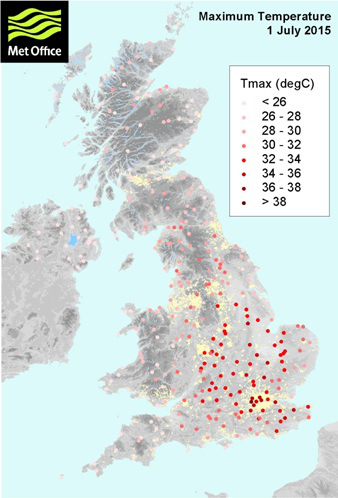
Map showing stations across the UK that recorded new high temperature records on 1 July 2015. Source: Met Office News blog (7th July)
McCarthy concludes that there is strong evidence that the Heathrow high temperature is genuine and not caused by local factors, and that 1 July was a record-breaking day across the country. He says:
“We’ve presented a wide range of evidence which shows why we have high confidence the record July temperature was accurate. We saw record heat across a broad area, with many stations breaking their July heat record and a few breaking their all-time temperature records.”
It’s worth noting that the Met Office isn’t saying this was the hottest day ever for the UK, just the highest temperature recorded in the UK on a July day.
Main image: An airliner comes in to touchdown in the sunset.
-
The Telegraph has claimed the Met Office was "forced to defend" the credibility of its data over Heathrow temperature record claims - @CarbonBrief analyses


